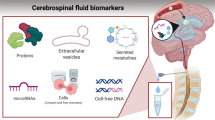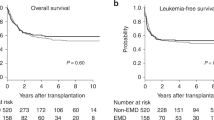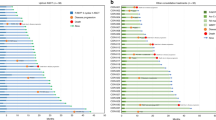Abstract
To determine the clinical significance of central nervous system (CNS) involvement at the time of diagnosis of pediatric acute myeloid leukemia (AML), we analyzed clinical features and outcomes of 290 patients treated consecutively on four institutional trials (AML80, AML83, AML87, and AML91). CNS status was classified as CNS1 (no blast cells in CSF; n=205), CNS2 (<5 WBC/μl CSF with blast cells; n=37), or CNS3 (⩾5 WBC/μl CSF with blast cells, or signs of CNS involvement; n=48). Patients with CNS3 status were significantly younger than others (P=0.016) and significantly more likely to have the favorable cytogenetic features t(9;11), t(8;21), or inv(16) (P<0.001). The CNS3 group had a significantly greater probability (±s.e.) of 5-year event-free survival (43.7±7.0%) than did the CNS1 (27.8±3.2%, P=0.015) and CNS2 (24.3±7.5%, P=0.032) groups. However, after adjustment for favorable genetic features, there was no significant difference in EFS between the CNS3 and the combined CNS1+CNS2 groups (P=0.075). In all, 10 of 151 patients treated on AML80 and AML83, but none of 139 treated on AML87 and AML91, had primary CNS relapse. CNS involvement had no adverse prognostic significance, and patients with CNS2 status had similar outcome to CNS1 patients in this large group of pediatric patients with AML, treated at a single institution.
This is a preview of subscription content, access via your institution
Access options
Subscribe to this journal
Receive 12 print issues and online access
$259.00 per year
only $21.58 per issue
Buy this article
- Purchase on Springer Link
- Instant access to full article PDF
Prices may be subject to local taxes which are calculated during checkout



Similar content being viewed by others
References
Dahl GV, Simone JV, Hustu HO, Mason C . Preventive central nervous system irradiation in children with acute nonlymphocytic leukemia. Cancer 1978; 42: 2187–2192.
Stavem P, Evansen SA . CNS involvement in acute myelomonoblastic leukemia. Br J Haematol 1984; 58: 383–384.
Creutzig U, Ritter J, Zimmermann M, Schellong G . Does cranial irradiation reduce the risk for bone marrow relapse in acute myelogenous leukemia? Unexpected results of the Childhood Acute Myelogenous Leukemia Study BFM-87. J Clin Oncol 1993; 11: 279–286.
Amadori S, Ceci A, Comelli A, Madan E, Masera G, Nespali L et al. Treatment of acute myelogenous leukemia in children: results of the Italian Cooperative Study AIEOP/LAM 8204. J Clin Oncol 1987; 9: 1356–1363.
Pinkel D, Woo S . Prevention and treatment of meningeal leukemia in children. Blood 1994; 84: 355–366.
Ravindranath Y, Steuber CP, Krischer J, Civin CI, Ducore J, Vega R et al. High-dose cytarabine for intensification of early therapy of childhood acute myeloid leukemia: a Pediatric Oncology Group study. J Clin Oncol 1991; 9: 572–580.
Pui CH, Dahl GV, Kalwinsky DK, Look AT, Mirro J, Dodge RK et al. Central nervous system leukemia in children with acute nonlymphoblastic leukemia. Blood 1985; 66: 1062–1067.
Woods WG, Kobrinsky N, Buckley J, Neudorf S, Sanders J, Miller L et al. Intensively timed induction therapy followed by autologous or allogeneic bone marrow transplantation for children with acute myeloid leukemia or myelodysplastic syndrome: a Children's Cancer Group pilot study. J Clin Oncol 1993; 11: 1448–1457.
Mahmoud HH, Rivera GK, Hancock ML, Krance RA, Kun LE, Behm FG et al. Low leukocyte counts with blast cells in cerebrospinal fluid of children with newly diagnosed acute lymphoblastic leukemia. N Engl J Med 1993; 329: 314–319.
Pui C-H . Toward optimal central nervous system-directed treatment in childhood acute lymphoblastic leukemia. J Clin Oncol 2003; 21: 179–181.
Blaney SM, Balis FM, Poplack DG . Current pharmacological treatment approaches to central nervous system leukaemia. Drugs 1991; 41: 702–716.
Liliemark J . The clinical pharmacokinetics of cladribine. Clin Pharmacokinet 1997; 32: 120–131.
Dahl GV, Kalwinsky DK, Mirro J, Look AT, Pui C-H, Murphy SB et al. Allogeneic bone marrow transplantation in a program of intensive sequential chemotherapy for children and young adults with acute nonlymphocytic leukemia in first remission. J Clin Oncol 1990; 8: 295–303.
Kalwinsky D, Mirro Jr J, Schell M, Behm F, Mason C, Dhal GV . Early intensification of chemotherapy for childhood acute nonlymphoblastic leukemia: Improved remission induction with a five-drug regimen including etoposide. J Clin Oncol 1988; 6: 1134–1143.
Arnaout MK, Radomski KM, Srivastava DK, Tong X, Belt JA, Raimondi SC et al. Treatment of childhood acute myelogenous leukemia with an intensive regimen (AML-87) that individualizes etoposide and cytarabine dosages: short- and long-term effects. Leukemia 2000; 14: 1736–1742.
Krance RA, Hurwitz CA, Head DR, Raimondi SC, Behm FG, Crews KR et al. Experience with 2-chlorodeoxyadenosine in previously untreated children with newly diagnosed acute myeloid leukemia and myelodysplastic diseases. J Clin Oncol 2001; 19: 2804–2811.
Bennett JM, Catovsky D, Daniel MT, Flandrin G, Galton DA, Gralnick HR et al. Proposed revised criteria for the classification of acute myeloid leukemia. A report of the French–American–British Cooperative Group. Ann Intern Med 1985; 103: 620–625.
Williams DL, Harris S, Williams KJ, Brosius MJ, Lemonds W . A direct bone marrow chromosome technique for acute lymphoblastic leukemia. Cancer Genet Cytogenet 1984; 13: 239–257.
Prentice RL, Kalbfleisch JD, Peterson Jr AV, Flournoy N, Farewell VT, Breslow NE . The analysis of failure times in the presence of competing risks. Biometrics 1978; 34: 541–554.
Gray RJ . A class of k-sample tests for comparing the cumulative incidence of a risk. Ann Stat 1988; 16: 1141–1154.
Grimwade D, Walker H, Oliver F, Wheatley K, Harrison C, Harrison G, et al, on behalf of the Medical Research Council Adult Children's Leukaemia Working Parties. The importance of diagnostic cytogenetics on outcome in AML: analysis of 1,612 patients entered into the MRC AML 10 trial. Blood 1998; 92: 2322–2333.
Rubnitz JE, Raimondi SC, Tong X, Srivastava DK, Razzouk BI, Shurtleff SA et al. Favorable impact of the t(9;11) in childhood acute myeloid leukemia. J Clin Oncol 2002; 20: 2302–2309.
Raimondi SC, Chang MN, Ravindranath Y, Behm FG, Gresik MV, Steuber CP et al. Chromosomal abnormalities in 478 children with acute myeloid leukemia: clinical characteristics and treatment outcome in a cooperative pediatric oncology group study – POG 8821. Blood 1999; 94: 3707–3716.
Woods WG, Kobrinsky N, Buckley JD, Lee JW, Sanders J, Neudrof S et al. Timed-sequential induction therapy improves postremission outcome in acute myeloid leukemia: a report from the Children's Cancer Group. Blood 1996; 97: 4979–4989.
Walter AW, Hancock ML, Pui CH, Hudson MM, Ochs JS, Rivera GK et al. Secondary brain tumors in children treated for acute lymphoblastic leukemia at St. Jude Children's Research Hospital. J Clin Oncol 1998; 16: 3761–3767.
Loning L, Zimmermann M, Reiter A, Kaatsch P, Henze G, Riehm H et al. Secondary neoplasms subsequent to Berlin–Frankfurt–Münster therapy of acute lymphoblastic leukemia in childhood: significantly lower risk without cranial radiotherapy. Blood 2000; 95: 2770–2775.
Hasle H, Helgestad J, Christensen JK, Jacobsen BB, Kamper J . Prolonged intrathecal chemotherapy replacing cranial irradiation in high-risk acute lymphatic leukemia: long-term follow-up with cerebral computed tomography scans and endocrinological studies. Eur J Pediatr 1995; 154: 24–29.
Leung W, Hudson MM, Strickland DK, Phipps S, Srivastava DK, Ribeiro RC et al. Late effects of treatment in survivors of childhood acute myeloid leukemia. J Clin Oncol 2002; 18: 3273–3279.
Reinhardt D, Thiele C, Creutzig U . Neuropsychological sequelae in children with AML treated with or without prophylactic CNS-irradiation. Klin Padiatr 2002; 214: 22–29, (article in German).
Woods WG, Neudorf S, Gold S, Sanders J, Buckley JD, Barnard DR et al. A comparison of allogeneic bone marrow transplantation, autologous bone marrow transplantation, and aggressive chemotherapy in children with acute myeloid leukemia in remission: a report from the Children's Cancer Group. Blood 2001; 97: 56–62.
Stevens RF, Hann IM, Wheatley K, Gray RG . Marked improvements in outcome with chemotherapy alone in pediatric acute myeloid leukemia: results of the United Kingdom Medical Research Council's 10th AML trial. Br J Heamatol 1998; 101: 130–140.
Creutzig U, Ritter J, Zimmermann M, Reinhardt D, Hermann J, Berthhold F et al, for the Acute Myeloid Leukemia – Berlin–Frankfurt–Münster Study Group. Improved treatment results in high-risk pediatric acute myeloid leukemia patients after intensification with high-dose cytarabine and mitoxantrone: results of study Acute Myeloid Leukemia Berlin–Frankfurt–Münster 93. J Clin Oncol 2001; 19: 2705–2713.
Razzouk BI, Raimondi SC, Srivastava DK, Pritchard M, Behm FG, Tong X et al. Impact of treatment on the outcome of acute myeloid leukemia with inversion 16: a single institution's experience. Leukemia 2001; 15: 1326–1330.
Crews KR, Ghandi V, Srivastava DK, Razzouk BI, Tong X, Behm FG et al. An interim comparison of a continuous infusion vs a short daily infusion of cytarabine given with cladribine for pediatric acute myeloid leukemia. J Clin Oncol 2002; 20: 4217–4224.
Acknowledgements
We thank Sharon Naron for expert editorial assistance.
Author information
Authors and Affiliations
Additional information
This study was supported by Grants CA 21765 and CA 20180 from the National Cancer Institute, by a Center of Excellence Grant from the State of Tennessee, and by the American Lebanese Syrian Associated Charities (ALSAC). C-H Pui is the American Cancer Society-FM Kirby Clinical Research Professor. This work was Presented in part at the 43rd annual meeting of the American Society of Hematology, December 2001, Orlando, FL, USA.
Rights and permissions
About this article
Cite this article
Abbott, B., Rubnitz, J., Tong, X. et al. Clinical significance of central nervous system involvement at diagnosis of pediatric acute myeloid leukemia: a single institution's experience. Leukemia 17, 2090–2096 (2003). https://doi.org/10.1038/sj.leu.2403131
Received:
Accepted:
Published:
Issue Date:
DOI: https://doi.org/10.1038/sj.leu.2403131
Keywords
This article is cited by
-
Central Nervous System Involvement in Adults with Acute Leukemia: Diagnosis, Prevention, and Management
Current Oncology Reports (2022)
-
Risk factors and clinical outcomes of acute myeloid leukaemia with central nervous system involvement in adults
BMC Cancer (2015)
-
ZNS-Bestrahlung bei Kindern mit akuter myeloischer Leukämie
Strahlentherapie und Onkologie (2013)
-
Leukemias and lymphomas: Treatment and prophylaxis of the central nervous system
Current Treatment Options in Neurology (2006)
-
CEBPα mutations in childhood acute myeloid leukemia
Leukemia (2005)



